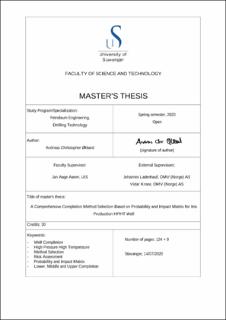| dc.description.abstract | HPHT well completion require special attention to well design. The conservatism of well completion is constantly put to the test by introducing and qualifying new equipment meant to enhance well performance, minimize HS&E risks, and provide a cost-effective design. Multiple operators on the Norwegian Continental Shelf has completed high-pressure, high-temperature wells with different completions and results. OMV (Norge) AS is set to look into a field development for PL 644 Hades/Iris field, and operational experience become highly valuable for their well completion strategy.
Completing a well requires the need to select the most ideal method. The reservoir completion needs to be designed to provide the most optimal exposure and flow of hydrocarbons. Providing an open hole completion introduce specific risks and considerations, so will a perforated liner. Completion fluids, perforation explosives, completion limitations and operational readiness for HPHT field is among many factors to influence the selection. The need for reservoir isolation contributes to additional considerations and risks, which again will influence the method selection with respect to well integrity. Tubing selection, packer design and load cases will dictate the upper completion method selection. This thesis shall provide a general method assessment of important completion components from reservoir to wellhead, where risks encountered from previous field developments is included.
By using real well information obtained from 6506/11-11S Iris Appraisal, a new production well shall be studied and completed. The method selection process will be carried out by a risk assessment matrix. Basing the likelihood and consequence of the identified risks, the risk level can be determined. This qualitative methodology is common in the industry and provide a straightforward overview of the mapped risks.
Based on the results from the risk register presented in this thesis, a method selection of lower, middle, and upper completion will be presented. Full completion proposals will be investigated and integrated, covering advantages and disadvantages, before concluding on a final proposal. | en_US |
